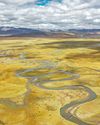
WALK ALONG THE SANDY BEACHES of Pasir Ris, Singapore at dawn, and a curious salad appears to wash up on the sands.
A peculiar mix of red, green, brown, and black seaweeds, these native species of entangled fronds arouse the curiosity of humans and animals alike. Mathilda D'silva, a Pasir Ris resident, was captivated by these seaweeds washing ashore and also seemingly thriving on the underside of the line of blue barrels, a coastal protection initiative in place by the Singapore national coast guard. She also noticed that they appeared to grow floating in the shallow pools by the shore, while some rooted themselves to the shallow sandbanks. These curious characteristics make this trending aquaculture crop notoriously difficult to understand, cultivate, propagate and quantify.
The term seaweed adds to the confusion, as seaweeds can be as tiny as microscopic phytoplankton that permeate the water column, powering the marine food chain. They can form massive, lush underwater forests, anchoring themselves with holdfasts instead of claw-like root anchors that attach to smooth, hard surfaces. D'Silva realised that many seaweeds were also attaching themselves to plastic trash that would wash up on the shores of Pasir Ris, fueling one of the reasons why she founded the Ocean Purpose Project (OPP).
“This set off a fact-finding mission in me to understand what I was seeing in Pasir Ris. During my corporate life in a bank, I had come across a seaweed entrepreneur, David Christian from Indonesia, who captured my imagination. We had hours of conversation trying to understand: Why does seaweed behave, grow, thrive the way that it does? What benefit do these hidden saviours of the sea hold?” says D'silva.
Why does seaweed behave, grow, thrive the way that it does? What benefit do these hidden saviours of the sea hold?.
Seaweed Cultivation
Diese Geschichte stammt aus der AG 06/2021 - 151-Ausgabe von ASIAN Geographic.
Starten Sie Ihre 7-tägige kostenlose Testversion von Magzter GOLD, um auf Tausende kuratierte Premium-Storys sowie über 8.000 Zeitschriften und Zeitungen zuzugreifen.
Bereits Abonnent ? Anmelden
Diese Geschichte stammt aus der AG 06/2021 - 151-Ausgabe von ASIAN Geographic.
Starten Sie Ihre 7-tägige kostenlose Testversion von Magzter GOLD, um auf Tausende kuratierte Premium-Storys sowie über 8.000 Zeitschriften und Zeitungen zuzugreifen.
Bereits Abonnent? Anmelden

A Spectrum Of Scarlet: The Symbolic Red Of Asian Flags
A common thread that unites many Asian flags is the prominent use of red, a colour rich with symbolism

Curry: A World of Flavour, Tradition, and Culture
From its humble beginnings in India, the concept of "curry" has evolved into a culinary language understood around the world

The Power Of Asian Red Fruits - Discover 10 Nutrient-Rich Gems Of The East
In the vast tapestry of Nature, Asia has gifted the world an array of unique and vibrant fruits, particularly those in shades of red. These scarlet-hued gems, packed with flavour and nutrients, not only add a burst of colour to your plate but also carry valuable health benefits. From antioxidant-rich goji berries to the exotic dragon fruit, let's explore some of the most popular red fruits from Asia and discover why they should be part of your diet.

Bhutan: A World Of Its Own
With its majestic monasteries, red-robed monks, charming rural villages, and vibrant festivals, the Kingdom of Bhutan is a Himalayan paradise that promises an enriching travel experience like no other

Take The Red Pill
From the vermilion torii gates of Japan to the famed rust-hued walls of India's Agra Fort, the burgundy robes of Burmese monks to scarlet chillies drying in the Bangladeshi sun, red is the quintessential colour of Asia.

70 Days for Our Land Animals
Raising awareness about conservation, the environment, and the land-dwelling species of the world

The Red Panda
Meet the elusive guardian of the Eastern Himalayas

Revealed Doctor Yellow
Japan Railways' special lemony Shinkansen is a rare sight to behold

The Mighty Yellow
Over 5,000 kilometres long and flowing through nine provinces and autonomous regions, the Yellow River is China's second largest, after the Yangtze, while its basin is deemed the cradle of Chinese civilisation

Wildlife Big Yellow Beauty
The popular "amelanistic" form of the Burmese python is considered among the most beautiful snakes - if that's your sort of thing